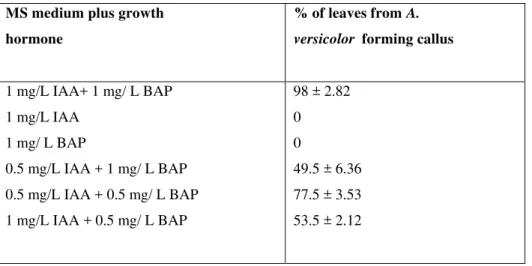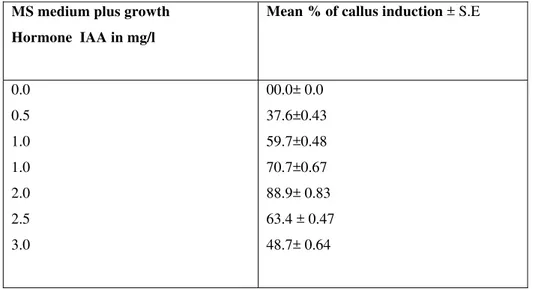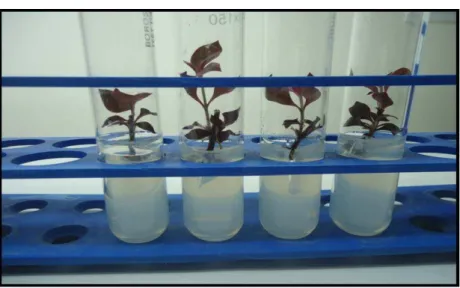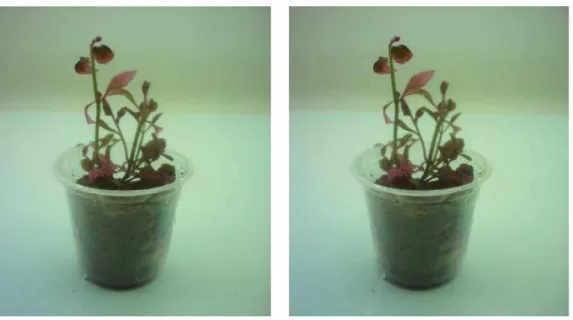IN VITRO
PROPAGATION OF
ALTERNANTHERA VERSICOLOR
(LINN.) - A MEDICINAL HERB
D. Preetha Assistant Professor, Department of Biotechnology, Faculty of Science & Humanities,
SRM University,
Kattankulathur, Kancheepuram – 603 203, Tamil nadu, India
preethad06@gmail.com K. Mahalakshmi Assistant Professor, Department of Biotechnology, Faculty of Science & Humanities,
SRM University,
Kattankulathur, Kancheepuram – 603 203, Tamil nadu, India
kgmahalakshmi@yahoo,co,in
M. Bhakyalakshmi Department of Biotechnology, Faculty of Science & Humanities,
SRM University,
Kattankulathur, Kancheepuram – 603 203, Tamil nadu, India
kgmahalakshmi@yahoo,co,in
ABSTRACT
A complete protocol for micropropagation of Alternanthera versicolor using leaf and internodal explants was developed. An explants from A. versicolor established on Murashige and Skoog medium were treated with various concentrations and combinations of auxins and cytokinins to determine the best method for callus formation, shoot regeneration and root formation. MS medium supplemented with 1 mg/l BAP and 1 mg/l IAA was determined to be the most suitable for callus induction. After 2 weeks, the callus was then transferred to shooting media which consisted of half strength MS basal medium, 1 mg/l IAA and 1 mg/ l BAP. After 4 weeks, structures were observed with their basal ends embedded on the callus. These structures turned into purple colored shoot buds. MS medium supplemented with 1 mg/l IAA and 1 mg/l BAP showed maximum shoot multiplication. For rooting, the optimal medium was half strength MS medium supplemented with 1 mg/l IAA. Rooted plantlets were then transferred to sand bag vessels which provided the high humidity environment. The hardened plants were then successfully established in the soil medium and can function in the natural environment.
Key words: Alternanthera versicolor, micropropagation, callus, shooting. 1. INTRODUCTION
Micropropagation is the practice of rapidly multiplying stock plant material to produce a large number of progeny plants, using modern plant tissue culture methods. Micropropagation is used to multiply novel plants, such as those that have been genetically modified or bred through conventional plant breeding methods. It is also used to provide a sufficient number of plantlets for planting from a stock plant which does not produce seeds, or does not respond well to vegetative reproduction. Frederick Campion Steward was the person who discovered and pioneered micropropagation and plant tissue culture in the late 1950s and early 1960s. He was one of Cornell's finest.
Plants are the main source of many modern medicines. It is estimated that approximately one quarter of prescribed drugs contain plant extracts or active ingredients obtained from or modeled on plant substances. Recent estimates suggest that over 9,000 plant species have known medicinal applications in various cultures and countries and this is without comprehensive research amongst several indigenous and other communities. In India, approximately 1700 plants species are used in Ayurveda, 500 for Siddha, 400 for Unani, 300 for Amchi systems of medicine with substantial overlaps of common plants among the system. Green leafy vegetables (greens) play a major role in the Sri Lankan diet, probably due to the influence of traditional herbal medicine, easy accessibility and low cost Furthermore, green leaves are considered as a main source of vitamins, minerals and fibre for the local consumers. Due to their dietary importance, many scientific studies have been carried out on the nutritive values of green leaves (Gayathri et al., 2006).
The in vitro propagation is an alternative tool for large scale multiplication and may increase the number of propagules for cultivation as well as aid the replacement of natural populations (Kumaraswamy and Anuradha, 2010; Jaimsha et al., 2010; Gokhale and Bansal, 2009; Bashir et al., 2008; Roy, 2008; Johnson et al., 2007; Johnson et al., 2005; Johnson ., 2004; Johnson and Manickam, 2003; Boro et al., 1998). Callus production and shoot regeneration from primary callus or hypocotyl explants have been reported by Flores et al. (1982), Flores and Teutonico (1986) in A. cruentus, A. hypochondriacus, A. tricolor and by Bagga et al. (1987) in A. paniculatus. Bennici et al.(1992) studied 4 different species of Amaranthus (A. audatus, A. hypochondriacus, A. cruentus and A. hybridus) for callus induction, growth and organogenesis. Bennici et al. (1997) studied in vitro behavior of A. cruentus, A. hybridus and A. hypochondriacus. Preliminary work on in vitro callus production was reported by Kayani, (2008). A few published reports are available on micropropagation of A. sessilis (Singh et al., 2009; Boro et al., 1998; Bennici and Schiff, 1997)
Alternanthera versicolor, Amaranthaceae family is a weed and occurs in both wetlands and uplands and can grow on a variety of soil types. The plant spreads by seeds, which are wind and water-dispersed and by rooting at stem nodes (Scher, 2004). It is a weed of rice throughout tropical regions and of other cereal crops, sugarcane and bananas. Although it is a weed, it has many utilities. Young shoots and leaves are eaten as a vegetable in southeast Asia (Scher, 2004). The young tips are eaten as a vegetable. The leaf is very rich in iron, vitamin A and dietary fiber. The plant contains protein and soups made with the leaf are given to anemic patients in rural areas. It contains abundant carotene, therefore it is used for curing night blindness. The plant enhances the secretion of milk in new mothers (Naples, 2005) and it is used as a remedy against intestinal cramps, diarrhoea and dysentery (intestinal disorder), and externally as a cooling agent to treat fever (Naples, 2005). Naples (2005) also reported that A. sessilis is used internally against intestinal inflammation, externally to treat wounds, to treat hepatitis, tight chest, bronchitis, asthma, lung troubles, to stop bleeding and as a hair tonic.
2. MATERIALS AND METHODS
Plants were collected from SRM University campus, Kattankulathur, Kancheepuram, Tamilnadu, India. Young shoots were harvested and washed with running tap water and surface sterilized in 0.05 and 0.1% mercuric chloride for 2, 3 and 5 min. After rinsing 3-4 times with sterile distilled water, shoot tip, leaves, stem nodes and internodes were cut into smaller segments (0.5 to 1.0 cm) used as the explants. The explants were placed horizontally (leaves and internodal segments) as well as vertically (shoot tip and nodal segments) on solid basal Murashige and Skoog (1962) medium supplemented with 3% sucrose, 0.7% (w/v) agar (Hi-Media) and different concentration (0.5-2.0 mg/l) and combination of BAP and Kin for in vitro shootlets regeneration. Regenerated shoots were separated from the cultures individually and used for root induction. The pH of the medium was adjusted to 5.8 before autoclaving at 121°C for 15 min. The cultures were incubated at 25 ± 2°C under cool fluorescent light (3000 lux 16 hr/d photoperiod). For rooting, the in vitro raised shootlets were transferred to the ½ MS medium augmented with different concentrations of auxins (IAA & IBA). Each and every experiment was performed with 20 replicates and repeated twice. For hardening, the in vitro raised plantlets were removed from culture, washed thoroughly with tap water planted in small polycups filled with sterile garden soil (3:1), covered by unperforated polybags, and hardened for 4 weeks in a mist chamber before transfer to field.
3. RESULTS AND DISCUSSION
3.1. Callus induction
Callus initiation was observed on the surface or cut ends of the explants after 14 days of inoculation. The best callus induction response for leaf explants of A. versicolor was observed on MS medium supplemented with 1 mg/l - IAA and 1 mg/l BAP. No callus induction was noted on 1 mg/l IAA or 1 mg/l BAP and the explants withered away. When equal concentrations of auxins and cytokinins were supplemented in the media high frequencies of callus induction were noted. When a high concentration of auxin (IAA) was used in combination with lower concentration of cytokinin (BAP), a low frequency of callus induction was noted . Similar development was observed in Amaranthus by Flores et al. (1982) and Bennici et al. (1992). When a high concentration of cytokinin was used with a low concentration of auxin, a low frequency of callus induction was noted. Hence the callus obtained from MS medium supplemented with 1 mg/l IAA and 1 mg/l BAP were used for further analysis. The callus obtained from internodal segment is 89.9± 0.83% on the MS basal medium supplemented with IAA(table2) The calli were subcultured into fresh medium every 2 weeks.
Table 1.Effect of growth regulators on callus induction from leaves of A.versicolor. MS medium plus growth
hormone
% of leaves from A.
versicolor forming callus
1 mg/L IAA+ 1 mg/ L BAP 1 mg/L IAA
1 mg/ L BAP
0.5 mg/L IAA + 1 mg/ L BAP 0.5 mg/L IAA + 0.5 mg/ L BAP 1 mg/L IAA + 0.5 mg/ L BAP
98 ± 2.82 0 0
Table 2. Effect of IAA on callus production from internodal segment A.versicolor. MS medium plus growth
Hormone IAA in mg/l
Mean %of callusinduction ± S.E
0.0 0.5 1.0 1.0 2.0 2.5 3.0
00.0± 0.0 37.6±0.43 59.7±0.48 70.7±0.67 88.9± 0.83 63.4 ± 0.47 48.7± 0.64
Figure Shows the callus proliferation from the explants(21 days)
3.2. Shoot regeneration from callus
Figure Shows the shoots intiation from the callus(15 days)
Figure Shows the shoots intiation from the callus(21 days)
3.4. Rooting of regenerated shoots
Figure shows the root formation from the shoots (15 days)
Figure showstransfer of plantlets in polycups
4. CONCLUSION
Tissue culture was carried out by the supplementation of plant growth regulators such as auxins(IAA,NAA and 2,4-D) and cytokinins (BAP and KINETIN) to the MS medium for the induction of callus. The type of growth regulators and concentrations used varied according to the cell purpose. In auxins,2,4-D was better when compared to IAA and NAA. In cytokinins, kinetins was better than BAP on callus induction. Both auxins and cytokinins were well suited for shoot initiation (apical bud, nodal explants). Both auxins and cytokinins produced better results on callus induction and shoot initiation. Auxins (IAA)and cytokinins (BAP) were supplemented in the MS medium to induce callus in the leaf and internode explants. The maximum callus induction from the leaf explants was 98% at the concentration of 1 mg/l IAA and 1 mg/l BAP and maximum callus induction from the internode explants was 88% when the medium supplemented with 2 mg/l IAA. The leaf explants gave better response than the internodal explants. The maximum number of shoots obtained was 10 from internodal explant when BAP and IAA amended in the MS medium at 1 mg/l and 1 mg/l BAP. The minimum number of shoots obtained was 2 from nodal explant when IAA was amended in MS medium at 1 mg/l. The optimal rooting was observed on the half strength MS medium supplemented with 1 mg/l IBA and 1 mg/l IAA.
The present study has resulted in the establishment of protocol for micropropagation of Alternanthera versicolor(L.) through leaf, shoot tip and nodal segments. This technique could be used as a tool for the large scale multiplication programmes.
ACKNOWLEDGMENT
I would like to acknowledge my dear colleagues for their support rendered. I extend my heartfelt regards to the management, Director and Dean FSH, SRM University for their constant support throughout the research work.
APPENDIX:
IAA – Indole Acetic Acid IBA – Indole Butyric Acid NAA – Naphthalene Acetic acid
2,4-D – 2,4 – Dichlorophenoxy Acetic Acid BAP – Benzyl Amino Purine
REFERENCES
[1] Anna Kalinina, Daniel C. W. Brown(2007). Micropropagation of ornamental Prunus spp. and GF305 peach, a Prunus viral indicator, Plant Cell Reports ,Volume 26, Number 7 927-93.
[2] Bagga S, Venkatesvarlu K, Sopory SK (1987). In vitro regeneration of plants from hypocotyls segments of Amaranthus paniculatus. Plant cell Reports, 6: 183-184.
[3] Bashir MA, Anjum MA, Rashid H (2008). In vitro propagation of some promising genotypes of jojoba (Simmondsia chinensis).Afr J Biotechnol . 7: 3878-3886.
[4] Bennici A, Schiff S (1997). Micropropagation of Amaranthus(Amaranth). In: Bajaj YPS (ed). Biotechnology in Agriculture and Forestry, Vol. 39: High-Tech and Micropropagation , pp. 20-29.
[5] Boro PS, ShrmaDeka AC, Kalita MC (1998). Clonal propagation of Alternanthera sessilis: A biopharmaceutically potent herbal medicinal plant. J. Phytol. Res. 11: 103-106.
[6] Flores HE, Teutonico RA (1986). Amaranths (Amaranthus spp.) Potential grain and vegetable crops. In: Y.P.S. Bajaj (ed). Biotechnology in Agriculture and Forestry, Vol. 2: Crops I pp. 568- 577.
[7] Flores HE, Their A, Galston AW (1982). In vitro culture of grain and vegetable Amaranth (Amaranthus spp.). Am. J. Bot. 69: 1049-1054.
[8] Gayathri BM, Balasuriya K, Gunawardena GSPS, Rajapakse RPVJ, Dharmaratne HRW (2006). Toxicological studies of the water extract of green leafy vegetable Sessilie joy weed(Alternanthera sessilis). Res Commu Curr Sci . 91: 1517-1520. [9] Gerald Martin, S. P. Geetha, Sudhakar S. Raja, A. V. Raghu, Indira Balachandran, P. N. Ravindran (2006), An efficient
micropropagation system for Celastruspaniculatus Willd.: a vulnerable medicinal plant.Journal of Forest Research ,Volume 11, Number 6, 461-465
[10] Gokhale, M., Bansal, Y.K. (2009). Direct in vitro regeneration of a medicinal tree Oroxylum indicum (L.) Vent. Through tissue culture. African Journal of Biotechnology. 8(16): 3777-3781.
[11] Jaimsha Rani VK, Fijesh PV, Padikkala J (2010). Micropropagation of Ophiorrhiza eriantha Wight. through Leaf Explant Cultures. Plant Tissue Cult Biotech. 20: 13-20.
[12] Johnson M, Berhanu A, Mulugeta K, Eyayu M, Manickam VS (2005). Regeneration from callus cultures of
Rhinacanthus nasutus L. Kurtz. Eth J Sci Technol. 3(1): 17– 24
[13] Johnson M, Manickam VS (2003). In vitro micropropagation of Baliospermum montanum (Willd.) Muell-Arg-A Medicinal Plant. Indian J Exp Biol. 41: 1349-1351.
[14] Johnson M, Manickam VS, Nikhat Y, Sonali D, Andal N (2004). In vitro multiplication of two economically important and endangered medicinal plants-Justicia gebdarussa Brum and Adeniahondala (Gaertn) De Wilde. Malaysian J Sci. 23: 49-53.
[15] Johnson, M. 2007. Somoclonal Variation studies on Phyllanthus amarus Schum and Thonn. Iran J Biotechnol. 3: 240-245.
[16] Kalyani S, Zia M, Sarwar S, Rehman R, Chaudharay MF (2008). Callogenic studies of Achyranthes aspera Leaf explants at different hormonal combinations. Pak J BiolSci . 11: 950-952.
[17] Kumaraswamy M, Anuradha M (2010). Micropropagation of Pogostemon cablin Benth. through Direct Regeneration for Production of True to Type Plants. Plant Tissue Cult Biotech 20: 81-89.
[18] Muhammad Azhar Bashir, Muhammad Akbar Anjum and Hamid Rashid(2008) In vitro propagation of some promising genotypes of jojoba (Simmondsia chinensis) African Journal of Biotechnology Vol. 7 (21), pp. 3878-3886
[19] Rejane Flores, Daniela Brondani Jr, Verciane Cezarotto Jr, Sandro Rogério Giacomelli, Fernando Teixeira NicolosoMicropropagation and β-ecdysone content of the Brazilian ginsengs Pfaffia glomerata and Pfaffia tuberosa (2010), Biomedical and Life Sciences In
Vitro Cellular & Developmental Biology - Plant Volume 46, Number 2 210-217
[20] Rout, G. R. Saxena, C. Samantaray, S. and Das, P.(1999), Rapid plant regeneration from callus culture of Plumbago zeylanica. Plant cell, tissue and organ culture Vol. 56, 47-51.
[21] Roy, A., Ghosh, S., Chaudhuri, M., Saha, P.K.(2008). Effect of different plant hormones on callus induction in Gymnema sylvestris
R.Br. (Asclepiadaceae). African Journal of Biotechnology. 7(13): 2209-2211.
[22] S. Echeverrigaray, R. Basso, L. B. Andrade (2005). Micropropagation of Lavanduladentata from axillary buds of field-grown adult plants Biologia Plantarum Volume 49, Number 3, 439-442.
[23] Scher J (2004). Federal Noxious Weed disseminules of the U.S. Center for Plant Health Science and Technology, Plant Protection and Quarantine, Animal and Plant Health Inspection Service, U.S. Department of Agriculture. Online. Available: http://www.lucidcentral.org/keys/v3/ FNW/ (Accessed 2007).
[24] Wesely Edward Gnanaraj, Johnson Marimuthu alias Antonisamy, Kavitha Marappampalayam Subramanian, Selvan Nallyan (2011) Micropropagation of Alternanthera sessilis (L.) using Shoot tip and Nodal segments, Iranian Journal of Biotechnology, Vol. 9(3), 206-213




